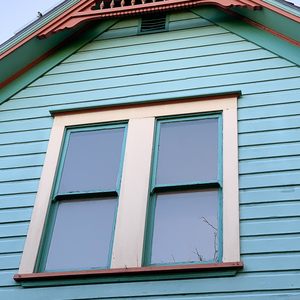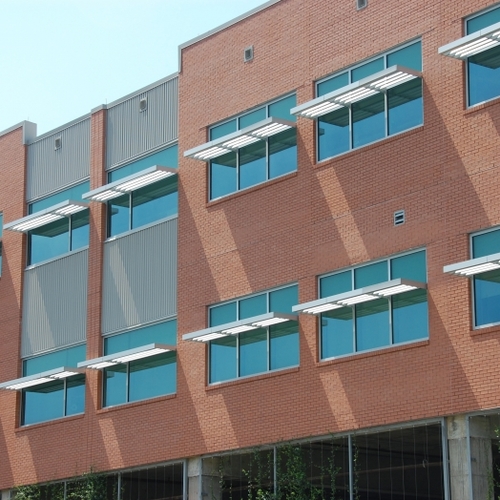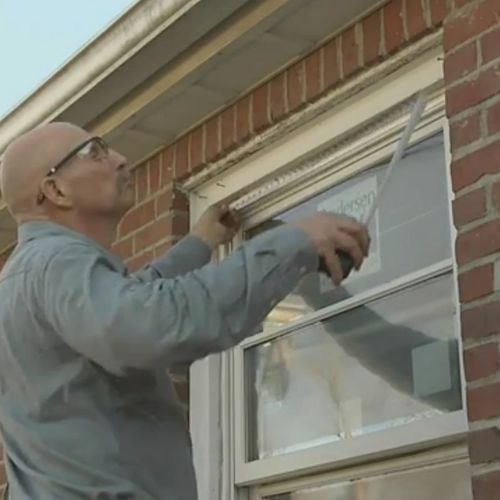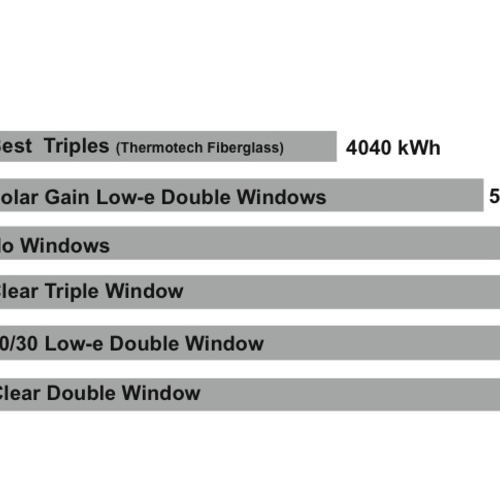Image Credit: Bold Little Swallow
Image Credit: Bold Little Swallow Installing window films can be done by homeowners, although it is very fussy work. An array of surface-applied films are designed for a variety of jobs: privacy, solar heat rejection, and even winter energy performance.
Image Credit: Photo: Solutia Performance Films
As I was hosing down the dirt driveway in front of my house last week to keep the dust down with some guests due to arrive, I got to thinking about Chicken Dinner Road.
I once lived in Canyon County, Idaho and often passed a junction for Chicken Dinner Road. Some years ago, I was told, this road was a dusty dirt track traveling between a few farms. One of the farmers got tired of the dust clouds that came up from passing vehicles. He had the local highway supervisor over for a chicken barbecue, and had a buddy driving up and down the road, demonstrating the problem directly. The road got paved, and it also got a name.
There’s another story about this same road — read on to the end. But one lesson I take from the ol’ chicken dinner: when something isn’t working, get creative and do something about it.
Cost-effective window fixes may not add R-value
If you have windows that have rotting sashes, failed seals (telltale sign: fogging between panes), extensive lead paint (especially in the part where the window slides), slapping on an extra layer of plastic or glass, as we talked about last week, may not solve your problem. If you want to save that old window, and maybe a few bucks, it’s time to get a bit more involved.
An air-sealing upgrade and repair package for the existing window can be the place to start. Professional air sealing and repair may involve replacing seals and gaskets throughout the window assembly, replacing double-paned glass or entire sashes if necessary, bringing window frames back into square, and repairing sash frames or the glass itself. While these repairs can be fairly cost-effective (if not always inexpensive), they do not add much R-value to the window — though replacing a sash pocket pulley system with a spring system and filling the air space with insulation will provide marginal improvements.
Combining approaches for better thermal performance
Air sealing does save energy as well as improve thermal comfort by closing off air leaks and reducing drafts, and it can be combined with high-performing storm windows or insulated shades to get up to four times better thermal performance without a pricey window replacement — a great option if you need shades for glare or privacy anyway, or if maintaining the look and feel of original windows is important. Improved operability can also save energy by allowing windows to be opened in the summer for ventilation.
“The only reason to replace a window is complete deterioration,” says Jean Carroon, an architect with Goody Clancy in Boston. Carroon specializes in historic preservation, and her work often leads to extensive restoration and repair of historic windows as well as the addition of attachments like interior panels — or even replacing windowpanes with insulated glass units in the historic window frame.
Most of today’s windows can’t be repaired
Carroon is distressed by the rate at which windows are replaced, especially since most of today’s double-glazed, low-e windows cannot be repaired. (I have learned this the hard way, naively taking one such broken window into the local hardware store, and then to the local glass repair shop, before finally taking the numbers off the unit to order a replacement from the dealer.)
Installing non-repairable windows leads to a “cycle of replacement” and is “a symbol of a non-sustainable world,” Carroon says. While restoring windows can be labor-intensive (and thus expensive), “you are almost always pouring the dollars into the local economy,” not sending it to far-away manufacturers, she notes.
Ten tips for deciding how to handle old windows
Here are some tips on deciding what do to with old, under-performing windows:
1. Replace existing windows only if they have failed or are in poor shape. Almost all windows need attachments, and opting for a higher-performance attachment, rather than a window replacement plus a new conventional attachment, may be a better solution.
2. Get a handle on the entire spectrum of possibilities from the last two weeks’ columns (on keeping the sun out, and on keeping the heat in), and by reviewing WindowAttachments.org, and then prioritize your needs.
3. Using these priorities, compare how well conventional window treatments meet these needs in comparison with more expensive but higher-performing window attachments.
4. Use the individual window attachment fact sheets (also at WindowAttachments.org) to gain a complete understanding of each option.
5. Look for and use credible resources — not manufacturer or sales claims — to support your window attachment decision-making. Two such resources are RESFEN and WINDOW 6.3 — free, downloadable software tools.
6. Select an attachment with multiple attributes; sometimes one attachment can solve multiple problems.
7. At the same time, understand that optimal management of heat loss and gain may require two window attachments — an interior one for the former and an exterior one for the latter.
8. Take care in combining double-glazed low-e windows with either low-e exterior storm windows or high-performance insulating interior attachments; deployment of either in managing solar gain during the summer may result in damage to the insulated glazing unit seals.
9. Understand what the proper maintenance will be for your attachments, and any operational needs. Awnings will work only if opened!
10. Prioritize energy performance in your window attachment decisions, but don’t forget to seek out nontoxic materials. While some window attachments typically come in only one form, the market is expanding rapidly. Recycled content, low-emitting materials, non-treated fabrics, and other green options may already be available.
More resources — and versions of the story
As with other recent columns, check out Making Windows Work Better, by Paula Melton and Peter Yost. That’s the recent feature article from Environmental Building News, and offers more detail on today’s advice along with other more comprehensive information.
Back to that chicken dinner: An online article tells me that one family on the fabled road back in the 1930s was friendly with the governor. They had him over for a nice chicken barbecue, and buttonholed him about the road. He agreed to keep it oiled if the county would grade and gravel it. The county agreed on it, and a legend was born.
Tristan Roberts is Editorial Director at BuildingGreen, Inc., in Brattleboro, Vermont, which publishes information on green building solutions.
Also in this series:
Windows, Shades, Blinds, and Awnings
Weekly Newsletter
Get building science and energy efficiency advice, plus special offers, in your inbox.
















4 Comments
Nope
I completely disagree with: "The only reason to replace a window is complete deterioration," and that all window problems can be solved with attachments.
I have about six reasons, but I really only need one:
All window attachments will eventually get removed, lost, stolen, stored then lost, broken, dirty, lost while cleaning, disrespected, painted badly, deteriorated seals, deteriorated wood, etc. After one of these things happens, then you are back to a bad old window with extra holes drilled in it. Since I've owned about 160 rental units, I've seen what the occupants and maintenance personnel will do (neglect being the most common)
A new window has very little chance of one of these bad things happening. Wood isn't a good material for weatherproofing. That's why you don't see wood anywhere on a car.
A new window has a much smaller chance of suffering one of these abuses. And it isn't true that you can't repair today's windows. Good glass shops can make a new double or triple glazed glass assembly for your old sash frame, even if it's cheap vinyl.
replacement wastes
Repair windows! Labor to repair old windows stays local. Window manufacturing plants harm the environment by the heat infernos required to flatten sheets of glass and all the petrol then truck replacment windows to the site. More and more small local shops are starting up and carpenters are teaching restoration trades. People just want to work. The environment can be helped, instead of hurt.
what other reasons?
Kevin, I'm interested in your other five reasons, because your one reason for not repairing windows, while it may be relevant on projects you're close to, is clearly not an universal truth.
It seems like there are a lot of reasons I don't see wood on a car, and its weatherproofing qualities are only one of those. Given the poor quality of the steel and plastics in most of today's cars, and the considerable energy burden from their manufacture, as well as health effects from the chemicals used, maybe we should give wood a second look. It has many really great qualities for buildings.
My experience with clad aluminum, divided lite, low-e windows is that the local shops cannot fix them. Portland Glass is a fairly reputable chain of shops in this region, and if they can't do it, who can I turn to except replacement by the dealer?
My Other Reasons
1. Wood swells and shrinks and therefore doesn't hold paint. So to restore an old wood window is to sign up for a lifetime of maintenance. I love wood for many things in houses, but just not where it can get wet.
2. After you restore an old wood window, you still have a single pane inefficient window that needs an attachment to even equal the performance of a new window. As stated above I am not convinced that window attachments have a useful lifetime of even a small fraction of a new window.
3. After you restore an old wood window and add an attachment that has a relatively short expected lifetime, you have spent more than if you had replaced it. (I've tried it and compared costs)
4. Old wood windows are covered in lead-based paint so I say get them the heck off my building so I don't have to face THAT issue anymore.
5. After you restore an old wood window, it's still very difficult to weather seal and air seal the old frame to the old sheathing of the old house. Complete removal and replacement with a new window makes those tasks quite a bit easier.
I've got a few more reasons but......
I haven't been thru the repair process with a window like you describe. So my advice is to stick with simple windows. All the vinyl and fiberglass frames I've seen make it easy to replace the insulated glass with a locally sourced custom cut glass assembly
Log in or create an account to post a comment.
Sign up Log in